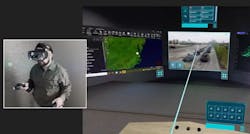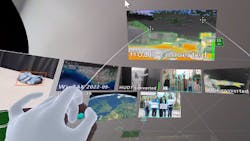New VR tool boosts situational awareness at operations centers
Commands centers are typically the backbone of many physical security programs, but they can be inflexible and cumbersome for an analyst working from remote locations.
Headwall VR plans to change that with software that allows for a digital twin of a command center to be instantiated in an extended reality headset. Headwall places secure video feeds, 3D data visualization and real-world hardware control into an immersive environment.
In situations that demand rapid decision making, Headwall enables operators not physically in the command center to benefit from the same level of situational awareness afforded to operators with access to a large-format video wall and 3D tools.
Templeton notes the product is designed to be content and source agnostic, fighting the aging trend in security of closed systems and architecture. The company’s software can bring in direct video feeds from surveillance cameras, drones, body cameras and other technology. Headwall VR has a tight integration with Google Maps and Bing Maps and more sophisticated integrations with Esri. The technology will be on display at GSX 2023 at booth 4074.
“What we do is essentially give someone a personal command center, a personal security operations center, that they can either see what's important to them and access any of the information that's available,” says Mark Templeton, Chief Revenue Officer for the Beltsville, Md.-based company.
“Someone like a security analyst in the operations center could push content to someone remote in leadership to let them get a lay of the land and make decisions. So it’s very flexible. You can be working on your computer, using your keyboard and mouse while being immersed in the virtual command center environment.”
Working from Anywhere
The Headwall system works identically to existing command centers with one exception: users can access and manipulate data anywhere in the world via a head-mounted AR or VR display without being in a physical command center.
Video outputs from an existing command center AV infrastructure are connected to the Headwall system. The video is converted to standard IP streams and decoded in a VR environment as full motion video streams.
From there, Headwall passes through full control of source routing, video wall layouts, display positioning, KVM routing, camera PTZ control and 3D visualization capabilities to the virtualized environment. Content is delivered over the WAN in a secure encrypted stream.
In addition to video wall visualization and control, Headwall allows for visualization of a facility or area of interest with a Li-DAR scan or GIS map. These 3D tools are integrated with IoT devices, GPS data or other sensors to provide a real-time digital twin of a facility operation.
Headwall VR takes the capabilities that would exist in a security operation center and make those available to remote personnel.
“The classic use case is we have a security leader for XYZ corporation and they have a serious event that happens at three o'clock in the morning in LA, and they happen to be in New York,” Templeton explains. “That person may be traveling. They might be in a hotel room. We can give them the ability to get eyes on glass and monitor and manage that situation the same way they would as if they were sitting in an actual physical security operations center.”
Quick Assessments
Headwall VR was incubated and developed over a two-year period and launched commercially in 2022. The only events the company has participated in outside of government shows was ISC West this year.
“Most of the team comes out of the systems integration community for audio-visual, so the security sector was not something that we knew a whole lot about,” said Mark Templeton, Chief Revenue Officer for the Beltsville, Md.-based company.
“For our target markets we certainly have some military and defense customers, and we have a public safety customer base as well, particularly law enforcement for their real-time crime center activities. But our largest market by far has been enterprise physical security. So that’s really the market that we want to try to get some exposure to at GSX.”
The majority of Headwall VR’s focus has been on the U.S. and Canadian market, particularly within the integration channel. Integrators who are embracing leading-edge technology are also helping the company get in front of end-user customers to discuss the software.
Templeton says this relationship makes it really easy to “bolt on” to existing projects already underway with integrators or at the end-user level if a network or security operations center is being built out.
“Typically that’s a construction project and it's lots of hardware and expense. For us to be able to say, ‘Hey, you’ve got all these amazing capabilities here. What if we could take this and make it available to you, your customers or your leadership to really see everything that's going on within your organization? We can do that very cost-effectively with a commercially available off-the-shelf VR headset and our software.”
Their optimal end users might be a security leader or possibly a global organization that needs to quickly teleport into a location and assess situations quickly and provide guidance without having to rely on third-hand information.
“We see a lot of that in the law enforcement space,” Templeton says. “It’s giving a first responder the ability to have the same level of situational awareness that someone in the real-time crime center would have. In defense applications, it’s taking what has historically been a large footprint-heavy, not-very-flexible operation center environment and extending that same sort of capability to a very small footprint as essentially someone sitting at a desk with a headset on.”
About the author: John Dobberstein is managing editor of SecurityInfoWatch.com and oversees all content creation for the website. Dobberstein continues a 34-year decorated journalism career that has included stops at a variety of newspapers and B2B magazines.
About the Author
John Dobberstein
Managing Editor/SecurityInfoWatch.com
John Dobberstein is managing editor of SecurityInfoWatch.com and oversees all content creation for the website. Dobberstein continues a 34-year decorated journalism career that has included stops at a variety of newspapers and B2B magazines. He most recently served as senior editor for the Endeavor Business Media magazine Utility Products.


